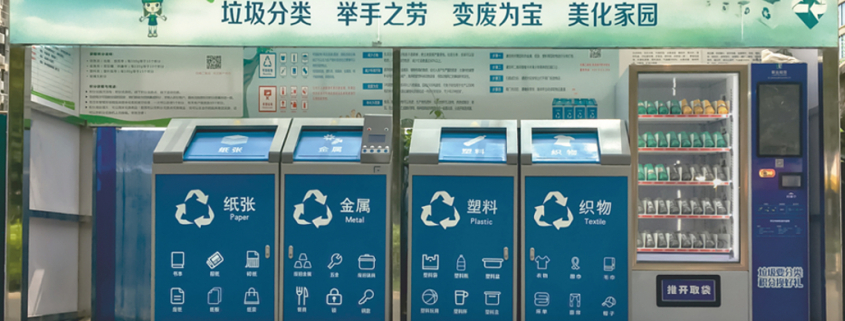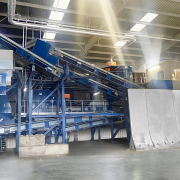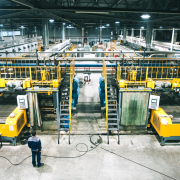China: On the Road to “Zero-Carbon”
The Government of the People’s Republic of China (PRC) is determined to steer the country to carbon neutrality by 2050. The circular economy – realized through national waste management and using recycled materials – is an important element on this strategic path.
The direction to more sustainability and a greener economy was clear since September last year. Back then, Chinese President Xi Jinping had announced to the United Nations General Assembly that the country would expedite its carbon emissions reduction targets ahead of its pre-existing voluntary commitments. However, sustainability objectives have been laid down in the country’s Five-Year Plans for at least two decades, German-based Mercator Institute for China Studies (MERICS) stated in the publication “’Greening’ China: An analysis of Beijing’s sustainable development strategies”. According to the independent research institute focusing on contemporary China, one of the key concepts to reach more sustainability is the circular economy – along with the key concepts “Ecological Civilization” (added to the constitution in 2018) and “Beautiful China” (long-term vision by 2049).
Even during the pandemic, the People’s Republic pursued its course of action: In April 2020, the “Law on the Prevention and Control of Environmental Pollution by Solid Waste” was revised and adopted; it came into effect in September the same year. The rule prohibits inter alia importing solid wastes – unless subject to a specific import license – and hazardous wastes. Furthermore, it contains stricter regulations on waste control, management and disposal.
Imports of secondary raw materials
In January this year, China imported the first batch of overseas recycling iron and steel materials after implementing the national standard on such raw materials, the Chinese state news agency Xinhua reported referring to the China Iron and Steel Association. About three thousand tons were shipped from Japan to Shanghai. The country’s move to make full use of overseas high-quality recycled iron resources would help “alleviate the irrational price rise of iron ore and scrap steel in the domestic market, as well as meet market demands”, an association’s official was quoted. The PRC had officially released the national standard on recycling iron and steel materials in December 2020, specifying the definition, classification, technical requirements, inspection methods and acceptance rules for recycling iron and steel materials.
In April this year, the imports of steel materials leaped by 67.3 percent to 76,250 tons, a special service for the steel sector informed referring to the country’s General Administration of Customs (GACC). As underlined, the higher volume would reflect the Chinese steel mills’ demand “now that import restrictions have been relaxed”. In the same month, Xinhua published that China would adjust tariffs on some steel products to lower import costs as part of efforts to push the domestic industry’s upgrading and transformation. From May on, the country intended “to apply a provisional zero import tax rate on pig iron, crude steel, recycled steel raw materials and ferrochrome”. According to the news agency, the adjustment aimed at supporting domestic producers to cut crude steel output, guiding the industry to reduce energy consumption, and pushing industrial upgrading and high-quality development in the sector.
Regarding non-ferrous metals, the demand is also high: The country’s January-April imports of copper materials totaled 531,261 tons, up by 81.7 percent from a year earlier, information provider Fastmarkets referred to the then-latest Chinese customs data published on May 20 this year. Malaysia, Japan and the USA were the top three suppliers of the material to China in April – imports from these three countries amounted to 76,382 tons – or 45.5 percent.
According to the website chinapaperonline.com, the imports of fibers grew strongly as well. In the first two months of this year, the country imported about 320,000 metric tons of paper-grade recycled pulp, 43.12 percent more than in the same period of the prior year. In January alone, more than 170,000 tons were received from abroad. As reported, the consistent price rise did not slow down active purchases from Chinese buyers, the special service provider referred to market analysts. Experts expect that the PRC’s recycled pulp demand will continue. Imports from overseas, including those supplies from Chinese investment in North America and Asia, were also set to rise significantly.
The volume of required financing
According to studies, the amount of money needed to realize China’s carbon-neutrality goal would be huge. At the same time, experts are convinced that the economic spin-off would be enormous. Therefore, many analysts regard implementing objectives and targets as the main investment opportunity for the next decades.
The Rocky Mountain Institute (RMI) and the Investment Association of China (IAC) share this view. The authors of the study “Zero-Carbon Investing: Opportunities from China’s Carbon-Neutrality Goal” are convinced that the country’s ambition “will activate the market and encourage more long-term value investors to focus on zero-carbon development and invest in zero-carbon assets, projects and technologies”. According to their estimation, the market size of seven key investment areas – resource recycling, energy efficiency, demand-side electrification, zero-carbon power generation, energy storage, hydrogen and digitalization – will reach nearly 15 trillion Yuan (converted 2.32 trillion US-Dollar) by 2050. These seven areas would also contribute 80 percent of China’s total emissions reductions by 2050, a RMI press release said.
However, the mentioned zero-carbon technologies were currently at different phases regarding market expectations and industrial maturity , the institute stated. “They, therefore, face different challenges and opportunities, which require different policy and market enablers to become more bankable.”
Resource recycling and projected market size
According to RMI and IAC, resource recycling could create a market value of 2.8 trillion Yuan (or 430 billion US-Dollar) by 2050. Concerning the goal of carbon-neutrality, the country would be able to reduce 40 billion tons of carbon emissions between 2020 and 2050, “meaning over 30 percent carbon reduction contribution for the zero-carbon transition”. The study identified three key areas:
- Products recycling in energy-intensive industries: By 2050, the reduction in demand for products in steel, cement, aluminum and plastic industries may reach the range of 16 to 53 percent with the potential of product recycling being fully unleashed, the authors of the study estimated. The share of recycled products is anticipated to reach 60 percent of total production.
- Waste as an energy source: Crop straw, forestry waste, domestic waste and animal manure would represent at least 370 million tce (tons of standard coal equivalent) energy potential per year, with straw accounting for 64 percent of the total, the authors of the report reckon. RMI’s analysis revealed that waste as an energy source could reduce carbon emissions by more than 13 billion tons between 2020 and 2050.
- Recycling of EV batteries for energy storage: With the pending market boom by 2050, it will become one of the main energy storage forms in the power system, the study predicts. RMI expects a market size of at least 114.5 billion Yuan (or 17.7 billion US-Dollar).
“Though the investment opportunities are clear, the complexity and diversification of the utilization of recycled resources determines that investors need to accurately grasp the market context for investment and act fast due to the rapid outbreak of the market,” RMI and IAC advised. Among the mentioned key areas, product recycling in energy-intensive industries and waste as an energy source were both at a relatively mature stage. These would require investors to seize the market trend that combines technology breakthroughs and business models and explore solutions that can scale rapidly. “However, recycling of EV batteries for energy storage is in a relatively early stage, with the focus still on technology breakthroughs and the establishment of industry standards.”
https://rmi.org/insight/zero-carbon-investing/
(Published in GLOBAL RECYCLING Magazine 2/2021, Page 6, Photo: Kostas2525 / dreamstime.com)








